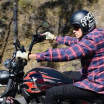Mini designer Alec Issigonis and performance tweaker John Cooper had a brain explosion in 1964 and developed a model with twin motors. Cooper crashed it, spent eight months in hospital and the idea was officially shelved. It hasn't stopped many backyard mechanics from having a go ever since, including Brisbane dentist Bill Westerman.
"Five years ago I was drinking beer with my friend Fred Sayers and we both decided to build one," he says in his garage littered with Mini engines in various states of rebuild. "Right from the word go — when the hangover cleared — we got stuck right into it."
His 1964 Mini Cooper S with a "worn-out" 1293cc engine in the front and another in the back is called "Nuts". "Because you have to be nuts to drive it and it's better with two," says Westerman with a cheeky grin.
"I don't know what I paid for this one. It came from a shell. I had a shed load of Minis at the time. It's a sickness, you know."
The graduate dentist began learning his mechanical skills from his first car which was a composite Series II Land Rover he made from two he bought at auction. His love of Minis started with his second purchase in 1969 when he bought a new Cooper S for $2500 and headed off to work in outback Waikerie, South Australia.
"I realised fairly quickly that what you really need in the outback is a V8, so I bought an XY Falcon ute," he says. "It went through a set of tyres every 6000 miles (9656km), a set of shocks every three months and universal joints at least once a year over those corrugated roads."
His next car was a modified VB Commodore V8 wagon donated to the young dentist by Holden. He had it about five years before returning to Brisbane, more study at the University of Queensland and the start of his amateur career racing Minis from 1986 to today.
"The aim was to race all the circuits in Australia and I've just about done that except for Perth and Darwin," he says. "I've had a lot of fun. Racing has been very good to me. I've always been in the middle of the pack because I didn't spend enough money on the race car to win."
His efforts to get more power out of a Mini and get further to the front of the pack led him down the ignominious Issigonis path of a twin-engined model. "We were worried after the first drive as it was an extremely difficult beast to keep on the road," he says. "There has to be co-ordination between the two motors. The gearing is the same and all the internals in the engine are the same, but we set the front so it was revving slightly harder so there is a bit of a pull factor."
The revelation that kept the beast on the road came from an article in a 1960s Sportscar World magazine about the Formula One Ferguson all-wheel-drive race car. "We got a lot of hints from that; you need an overdrive diff on the front and back," he says. "We put one in the front and it made a bit of a difference and then we put one in the back and all of a sudden it goes. The diff takes up the front-to-back bias. It used to crab before that."
The other major problem was the suspension. "Minis usually understeer, but this one was really taily at the start, not because of the weight in the rear but the front suspension we put in the rear. The problem was the back castor ... it had too much toe-in and we had to remove it. Instead of a steering box and steering geometry we made it into a straight-ahead suspension. Now I can drive it over all the ripple strips and still maintain control of the car. We have handling reasonable so now we are after more horsepower."
Two more powerful engines in various stages of rebuild are sitting on the floor of his garage waiting to be thrown into the "Nuts" car. "I have the theoretical knowledge of mechanics to build an engine but Fred has the practical knowledge to make it work," he says. "It's been an interesting engineering exercise."
Unfortunately, the car won't be ready in time for the second annual Cootha Classic hillclimb which Westerman organises for the Historic Racing Car Club of Queensland. "Maybe next year," he says.
The Cootha Classic will be held on May 29-30 featuring more than 250 cars and about 50 motorcycles from the 1920s to today in timed sprints around a 1450m track up and down Sir Samuel Griffith Drive with seven corners and chicanes.
Racing starts at 8.30am. Entry is $20 a day, $15 for concession, $30 for a two-day pass and $5 for parking in the J.C. Slaughter Falls carpark.
Visit: www.visitbrisbane.com.au.





.jpg)
.jpg)

.jpg)
_0.jpg)


.jpg)















.jpg)
.jpg)










